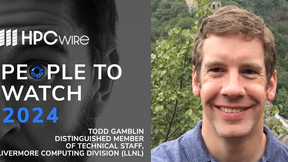Lawrence Livermore researchers awarded a billion supercomputer core hours
Open to researchers from academia, government labs and industry, the INCITE program is the major means by which the scientific community gains access to some of the fastest supercomputers. The program aims to accelerate scientific discoveries and technological innovations by awarding, on a competitive basis, time on supercomputers to researchers with large-scale, computationally intensive projects that address grand challenges in science and engineering. This year, nearly 6 billion core hours were awarded to 59 projects.
The LLNL recipients:
David Bader and Stephen Klein: 150 million core hours for "High-Resolution Simulation for Climate Means, Variability, and Extreme" -- Climate science predicts that the frequency of extreme events is likely to increase as greenhouse gas concentrations increase, but the picture can be confusing.
Climate models currently used in climate change studies only partially resolve many of the meteorological aspects important to the formation and representation of these climate features. The project proposes to quantify the benefits of employing very-high-resolution global models with enhanced tracer transport to investigate these issues. The team includes co-investigators from Sandia National Laboratories (SNL), ORNL, Lawrence Berkeley National Laboratory (LBNL), ANL, Los Alamos National Laboratory (LANL) and Pacific Northwest National Laboratory (PNNL).
Nicolas Schunck: 204 million core hours for "Nuclear Structure and Nuclear Reactions" -- Developing a comprehensive description of all nuclei (stable and unstable) and their reactions requires investigations of rare and exotic isotopes with unusual proton-to-neutron ratios that are difficult to produce and study experimentally because of their short lifetimes. This project will result in state-of-the-art simulations that provide needed predictions where direct experiment is not possible or is subject to large uncertainties. Such calculations are relevant to many applications in nuclear energy, nuclear security and nuclear astrophysics, since rare nuclei lie at the heart of nucleosynthesis and energy generation in stars. The team includes co-investigators from Iowa State University, LANL, ORNL, TRIUMF, University of Tennessee-Knoxville and ANL.
Frederico Fiuza (principal investigator), Dmitri Ryutov and Bruce Cohen:120 million core hours for "Particle Acceleration in Shocks: From Astrophysics to Laboratory in Silico" -- This project focuses on longstanding scientific problems closely tied to extreme plasma physics processes, such as identifying the dominant acceleration mechanisms for cosmic rays, and determining whether it is possible to generate relativistic shocks in the laboratory and to mimic these extreme cosmic accelerators. In particular, the team will unveil the internal workings of cosmic accelerators and study how collisionless shocks, which are pervasive in astrophysical scenarios, operate to accelerate particles to very high energies. This understanding will be used to identify optimal conditions to study these shock structures and associated acceleration in a laboratory using high-power lasers. The team includes co-investigators from the University of California, Los Angeles and Portugal's Instituto Superior T?(C)cnico.
Todd Gamblin, Katherine Yelick and Bronis de Supinkski:75 million core hours for "Performance Evaluation and Analysis Consortium (PEAC) End Station" -- This project focuses on a series of goals that will provide the performance research community with tools, run times and methodologies to enable scientists to exploit leadership-class systems and how to use each system most efficiently. The team includes co-investigators from LBNL, ANL, San Diego Supercomputer Center, the University of California, Berkeley, the University of Tennessee, ORNL, the University of Illinois at Urbana-Champaign, the University of Utah, the University of Maryland, PNNL, the University of Southern California's Information Sciences Institute, the University of Oregon, Rice University and the University of Wisconsin.
Miguel Morales: 200 million core hours for "QMC Simulations Database for Predictive Modeling and Theory" -- The project will involve quantum Monte Carlo (QMC) studies in heterogeneous catalysis of transition metal nanoparticles, phase transitions, properties of materials under pressure and strongly correlated materials. These research directions share a common need for predictive simulations where the relevant energy scales are small enough to be beyond the reach of other methods. The project will produce direct answers to fundamental materials science questions and establish benchmark levels of accuracy that will provide targets for future developments in related electronic structure approaches. The team includes co-investigators from ORNL, the University of Illinois at Urbana-Champaign, Purdue University, the University of California, Berkeley and SNL.
Brandon Wood: 60 million core hours for "Safety in Numbers: Discovery of New Solid Li-ion Electrolytes" - Researchers will use high-throughput computational screening combined with in-depth ab initio dynamics simulations to discover and optimize new classes of Li-ion solid inorganic electrolytes to enable safe high-energy batteries. The effort will advance the state of the art of intensive computational discovery and understanding of new classes of electrolyte materials, with potential relevance to battery systems, fuel cells and sensors. The team includes co-investigators from Bosch and Switzerland's ?0cole Polytechnique F?(C)d?(C)rale de Lausanne.
Steven Langer (principal investigator) and Denise Hinkel: 200 million core hours for "Simulation of Laser-Plasma Interaction in National Ignition Facility Experiments" -- The National Ignition Facility is carrying out experiments to compress a mixture of deuterium and tritium to temperatures and densities high enough to produce fusion ignition. The laser intensity at NIF is high enough that some of the laser energy backscatters off the target. This project will focus on simulations producing synthetic data that can be compared to experimental data from NIF to gain insight into the generation of backscattered light.
Contact
 Breanna Bishop
Breanna Bishop
[email protected]
(925) 423-9802
Related Links
MiraTitan
Award Listing
INCITE
Tags
HPC, Simulation, and Data ScienceSupercomputer
Computing
Featured Articles








